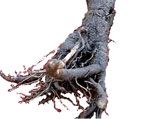



Burdock Root is considered to be native in Europs and Northern Asia; it is neutralized in the US. Burdock Root is widely cultivated in Eastern Europe especially former Yugoslavia, Poland, Bulgaria and Hungary. The plant is a perennial or biennial herb, growing up to 3 meters (about 9 feet), with large ovate, acuminate leaves, broad pinkish flowers made up of reddish-violate tubular florets, sur?rounded by many involucral bracts ending in a stiff spiny or hooked tip. Overall, these are rounded and spiny in appearance. The root pieces are used in teas and are very hard, minimally fibrous, longitudinally wrinkled and grayish brown to balck in color.
In traditional medicine, the fruits (seeds), roots and leaves of Burdock Root have been used as decoc?tions or teas for a wide range of ailments including colds, catarrh, gout, rheumatism, stomach ailments, cancers and as a diuretic, diaphoretic and laxative. It has even been promoted as an aphrodisiac. Externally, it has been used for various skin problems.
Burdock root yields a wide variety of com?pounds on analysis that include inulin (up to 50%), tannins, polyphenolic acids (caffeic and chlorogenic), volatile acids (acetic, butyric, costic, 3-hexenoic, isova?leric, 3-octanoic, propionic, etc), polyacetylenes (0.001-0.002%, dry-weight basis), and a crystalline plant hormone, glamma-guanidino-n-butyric acid. Studies con?ducted have isolated and characterized a xyloglucan from the 24% KOH extract of edible Burdock Root? The seeds of Burdock Root yield 15% to 30% fixed oils; a bitter glycoside (arctiin), two lignans (Iappaols A and B), chlorogenic acid, a germacranolide and other materials. Other studies have isolated six compounds from burdock seeds including daucosterol, arctigenin, arctiin, matairesinol, lappaol and a new lignan named neoarctin.4 The levels of arctiin and arctigen in the fruits of Burdock Root that are used in Chinese medicine for the treatment of common colds have also been studied.5 Others have also reported on the fruit constituents,6 and even the fruit pulp (pomace). The IruIT pulp contains 11% proteins, 19% lipids and 34% .
Several researchers have reported on the various biological acitivites of Burdock Root which include antipyretic, antimicrobial, antitumor, diuretic, and diaphoretic properties. Beyond these effects are reported fruit extracts with hypoglycemic activity in ra!s and fresh root juices with antimutagenic effects probably due to a lignan. Some cosmetic and toiletry type prod. ucts used for skin-cleaning, antidandruff and hair tonic applications are given in the recent literature. It should be noted that burdock root is fairly commonly used as a 1000 in Asia. Occasionally, US health food stores carry Iresh burdock root for sale as a food and nutraceutical (medical food). Among the more recent studies are the uses 01 Burdock Root in the treatment of urolithiasis,8 potential inhibit tion of HIV-1 infection in vitro,9 metabolism of Burdock Root lignans in rat gastrointestinal tract,10 platelet activating factor (PAF) antagonism by Burdock Root,11 effects of Burdock Root dietary fiber in digestion,12 lack of effectiveness of bur. dock in treating streptozotocin diabetic mice,13 potential antitumor activity of Burdock Root extract14 and a desmu. tagenic factor isolated from Burdock Root.
While Burdock Root is generally considered a safe and edible food product, a few reports have ap. peared on Burdock Root tea poisoning 16 due to adulteration (subsequently shown to be extraneous atropine), and allergic contact dermatitis due to Burdock Root.
Burdock root is generally considered an edible food product with some potential medical benefits as a mild diuretic, diaphoretic, antipyretic, antimicrobial and possible antitumor product. Many of the recenl chemical and pharmacological studies verify some these activities. Further investigations are warranted, particularly as a potential medical food or nutraceutical.
Copyright © Krishna Herbal Company 2022. All Rights Reserved Powered By: Planet Ayurveda







